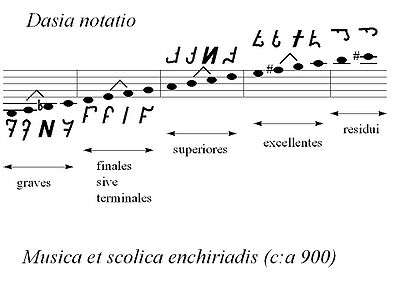Musica enchiriadis
Musica enchiriadis is an anonymous musical treatise of the 9th century. It is the first surviving attempt to set up a system of rules for polyphony in western art music. The treatise was once attributed to Hucbald, but this is no longer accepted.[1] Some historians once attributed it to Odo of Cluny (879-942).[2] It has also been attributed to Abbot Hoger (-906).[3]
This music theory treatise, along with its companion text, Scolica enchiriadis, was widely circulated in medieval manuscripts, often in association with Boethius' De institutione musica.[4] It consists of nineteen chapters; the first nine are devoted to notation, modes, and monophonic plainchant.[4]
Chapters 10-18 deal with polyphonic music. The author here shows how consonant intervals should be used to compose or improvise the type of early-medieval polyphonic music called [4] organum, an early style of note-against-note polyphony several examples of which are included in the treatise.[4] (Scolica enchiriadis also observes that some melodies should be sung "more quickly" (celerius), others "more slowly" (morosius).) The last, nineteenth, chapter of Musica enchiriadis relates the legend of Orpheus.[4]

The scale used in the work, which is based on a system of tetrachords, appears to have been created solely for use in the work itself, rather than taken from actual musical practice.[1] The treatise also uses a very rare system of notation, known as Daseian notation. This notation has a number of figures which are rotated ninety degrees to represent different pitches.
A critical edition of the treatises was published in 1981, and an English translation by Raymond Erickson in 1995.[4]
See also
References
- 1 2 Hoppin, Richard H. Medieval Music. Norton, 1978, pp.188-193.
- ↑ Finney, Theodore M. A History of Music. Harcourt, Brace and Company, 1935, p. 61
- ↑ Wright, Craig and Simms, Bryan. Music in Western Civilization. Schirmer Cengage Learning, 2010, p. 52
- 1 2 3 4 5 6 Erickson, Raymond. "Musica enchiriadis, Scholia enchiriadis". The New Grove Dictionary of Music and Musicians. London: Macmillan, 2001.
External links
- Anonymous (1981). Hans Schmid, ed. Musica et scolica enchiriadis una cum aliquibus tractatulis adiunctis. Veröffentlichungen der Musikhistorischen Kommission. 3. Munich: Bayerische Akademie der Wissenschaften; C. H. Beck. pp. 1–59. Retrieved 6 August 2013.
- Link to colour images of the MS of the text (I-Rvat pal. lat. 1342) available via the University of Heidelberg's site.
- Link to colour images of the MS of the text (D-Msb Clm 14372) available via the Bavarian State Library.